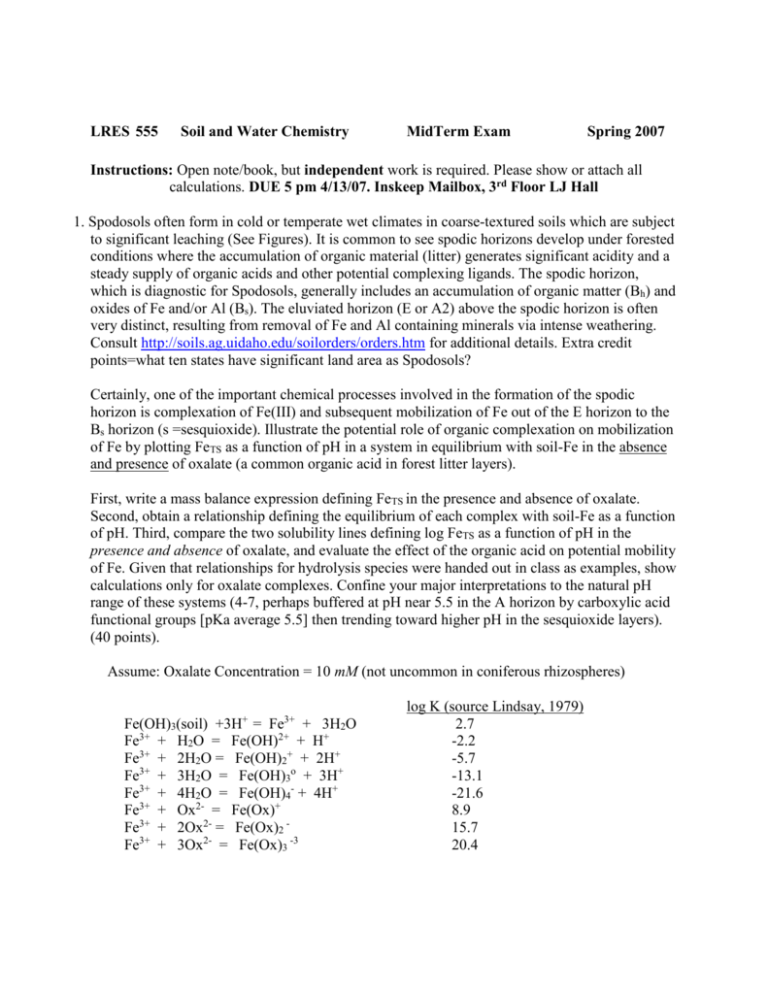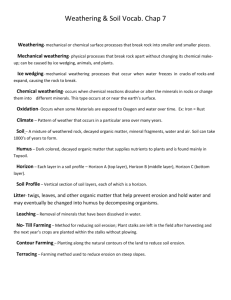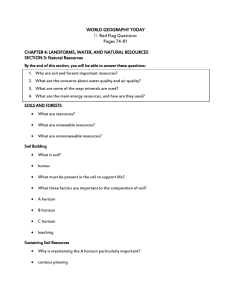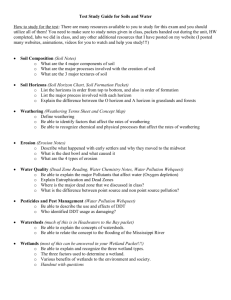Document 7774963
advertisement

LRES 555 Soil and Water Chemistry MidTerm Exam Spring 2007 Instructions: Open note/book, but independent work is required. Please show or attach all calculations. DUE 5 pm 4/13/07. Inskeep Mailbox, 3rd Floor LJ Hall 1. Spodosols often form in cold or temperate wet climates in coarse-textured soils which are subject to significant leaching (See Figures). It is common to see spodic horizons develop under forested conditions where the accumulation of organic material (litter) generates significant acidity and a steady supply of organic acids and other potential complexing ligands. The spodic horizon, which is diagnostic for Spodosols, generally includes an accumulation of organic matter (Bh) and oxides of Fe and/or Al (Bs). The eluviated horizon (E or A2) above the spodic horizon is often very distinct, resulting from removal of Fe and Al containing minerals via intense weathering. Consult http://soils.ag.uidaho.edu/soilorders/orders.htm for additional details. Extra credit points=what ten states have significant land area as Spodosols? Certainly, one of the important chemical processes involved in the formation of the spodic horizon is complexation of Fe(III) and subsequent mobilization of Fe out of the E horizon to the Bs horizon (s =sesquioxide). Illustrate the potential role of organic complexation on mobilization of Fe by plotting FeTS as a function of pH in a system in equilibrium with soil-Fe in the absence and presence of oxalate (a common organic acid in forest litter layers). First, write a mass balance expression defining FeTS in the presence and absence of oxalate. Second, obtain a relationship defining the equilibrium of each complex with soil-Fe as a function of pH. Third, compare the two solubility lines defining log FeTS as a function of pH in the presence and absence of oxalate, and evaluate the effect of the organic acid on potential mobility of Fe. Given that relationships for hydrolysis species were handed out in class as examples, show calculations only for oxalate complexes. Confine your major interpretations to the natural pH range of these systems (4-7, perhaps buffered at pH near 5.5 in the A horizon by carboxylic acid functional groups [pKa average 5.5] then trending toward higher pH in the sesquioxide layers). (40 points). Assume: Oxalate Concentration = 10 mM (not uncommon in coniferous rhizospheres) + 3+ Fe(OH)3(soil) +3H = Fe + 3H2O Fe3+ + H2O = Fe(OH)2+ + H+ Fe3+ + 2H2O = Fe(OH)2+ + 2H+ Fe3+ + 3H2O = Fe(OH)3o + 3H+ Fe3+ + 4H2O = Fe(OH)4- + 4H+ Fe3+ + Ox2- = Fe(Ox)+ Fe3+ + 2Ox2- = Fe(Ox)2 Fe3+ + 3Ox2- = Fe(Ox)3 -3 log K (source Lindsay, 1979) 2.7 -2.2 -5.7 -13.1 -21.6 8.9 15.7 20.4 2. Lead is capable of forming a variety of phosphate minerals in soils which may be as important as other solid phases often assumed to be important in controlling Pb2+ activity. You are asked to evaluate whether Pb5(PO4)3OH(hydroxypyromorphite, HP) may potentially control Pb2+ activities in oxidized surface soil environments. To evaluate the stability of this solid relative to other possible solid phases of Pb, construct a solubility diagram describing Pb2+ activity in equilibrium with the following Pb solid phases using the following equilibria and stated assumptions. Interpret the solubility diagram addressing what solid phases of Pb appear to be the most thermodynamically stable phases across a common pH range of interest (e.g. pH 3 to 9) (40 points). Solid Phase Reactions involving Pb2+ + Pb5(PO4)3OH (hydroxypyromorphite, HP) + 7H = 5Pb PbCO3 (cerussite) + 2H+ = Pb2+ + CO2(g) + 2H2O PbSO4 (anglesite) = Pb2+ + SO42Pb(OH)2 (solid) + 2H+ = Pb2+ + 2H2O 2+ - + 3H2PO4 + H2O Log K -4.1 4.7 -7.8 8.2 Other Reactions and Assumptions FePO4.2H2O(strengite) + 2H+ = Fe3+ + H2PO4- + 2H2O Fe(OH)3 (soil) + 3H+ = Fe3+ + 3H2O Ca5(PO4)3OH (hydroxyapatite, HA) + 7H+ = 5Ca2+ + 3H2PO4- + H2O -6.9 2.7 14.5 At pH values < 6, assume strengite and soil Fe(OH)3 control H2PO4- activities. At pH values >6, assume that hydroxyapatite (HA) controls H2PO4- activities where (Ca2+) = 10-3 M. The partial pressure of CO2(g) =0.003 atm, approximately 10 times atmospheric, and the activity of sulfate is assumed = 10-3 M. Note: The solubility function for HP solid will be discontinuous at pH 6. 3. Cation exchange capacity in soils and sediment systems can come from multiple sources. Estimate the CEC (mmolc g-1) of the following two systems, one a fertile midwestern farm soil, and the other an alpine site in granitic parent material. (20 points). Northern Farm Soil Alpine Site OC Clay Silt Sand --------------%---------------3.4 28 32 50 0.4 4 22 74 Profile Depth m 1 0.1 Annual Precip. m 0.2 0.8 pH 5.5 4 A. Obtain your estimate of the CEC for the soil by obtaining CEC values of the various solid phases. State your assumptions. B. Cation exchange is a very important process that will buffer changes in pH. Calculate the proton inputs on an annual basis for each site, and estimate the number of years required to exhaust the ‘profile’ CEC of each site (e.g. all exchange sites reacted with protons). The pH given is the average rainfall pH for each site. Reminders: Assume bulk density = 1.3 g cm-3





